|
|
Photographer, Location |
Larger images |
Comments |
 |
Phil Harrington,
Smithtown, NY |
#1,
#2, more |
Harrington: "[I captured] this
photo montage of yesterday's eclipse with my 4-inch f/9.8
refractor and an Olympus D360-L digital camera. The other
photo is a double exposure of the eclipsed Sun placed within
a forest of snow-covered pines." |
 |
Dan
Hawrylkiw, Sedona, AZ |
#1 |
This photo was taken from Oak Creek Canyon, near
Sedona AZ. Dan captured the Sun rising behind a pine tree on
the canyon wall using a Meade ETX and a 35mm SLR at 9:35 AM local
time. |
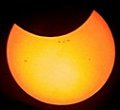 |
Michael Blackburn,
Boise, Idaho |
#1 |
M. Blackburn captured this image from Boise,
Idaho on December 25th, 2000 at approximately 9:35 a.m. local
time. Blackburn: "I used a Canon PowerShot S10 set on manual
so the camera would not flash. The photo was taken hand held
and through a 25 mm eyepiece on a 10" Coulter Dobsonian
telescope." |
 |
Evan
J. Gnam, Madison, WI |
#1,
#2 |
E. Gnam (physics teacher, Edgewood High School,
Madison, WI): "My pictures were taken with a digital camera
with no special settings. Both pictures are projections through
binoculars. It's amazing how
big a projection you can get with the sun as a light source!" |
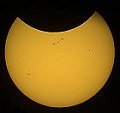 |
Doug Murray,
Palm Beach Gardens, FL |
#1 |
D. Murray captured this image on Dec. 25, 2000
at 12:14 Eastern Daylight Time. He used a Celestron 9.25"
SCT with a 3" off-axis filter using Baader AstroSolar Safety
Film (Density 5 -Visual) and a Nikon D1 digital camera set at
ISO 200, 1/250 second at f6.3. |
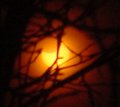 |
Mark
Mears, Huntland, TN |
#1 |
M. Mears: "I captured this image using a
Sony DSC-S70 digital camera. It was taken at a time when thin,
high clouds were moving in." See more
of Mark's work. |
 |
David Brown & Mitzi
Adams, Huntsville, AL |
#1,
#2 |
Using an Olympus 3030z digital camera, David
Brown and Mitzi Adams
captured this image of the partial solar eclipse through the
clouds over Huntsville, AL. |
 |
NOAA
Space Environment Center, Ramey, Puerto Rico |
(animation) |
A solar observatory in Ramey, Puerto Rico captured
this animation of
the partial eclipse as seen through an H-alpha
filter. |
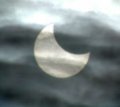 |
Tom Warner,
Rapid City, South Dakota |
#1,
more |
Tom Warner: "Clouds threatened to cancel
the show as viewed from Rapid City, South Dakota. However, the
clouds gradually broke and allowed me to take these images. I
used a Televue Pronto telescope, Televue eyepieces, Thousand
Oaks solar filter and Nikon Coolpix 950 set up for eyepiece projection." |
 |
Mark
Whitcombe, Toronto, CA |
#1 |
M. Whitcombe: "A simple shot of a simple
method of viewing the eclipse!" |
 |
Max Riseman,
Portland, ME |
#1 |
This picture is unremarkable except for one thing:
Max Riseman used two blank "blue on silver" CD-Rs (Compact
Disc Recordable) as makeshift solar filters for his Kodak DC280
camera. "I actually took two sets of pix, one with one CD-R,
and another set through two CD-Rs. Using one disc was not enough,"
says Riseman. |
 |
Vic Stover,
Waldo OH |
#1 |
Vic Stover captured this image of the partial
eclipse at 12:28pm local time in Waldo, Ohio. Photo settings:
Meade ETX90EC telescope, eyepiece projection Meade 40mm eyepiece,
Sony Mavica FD71 camera handheld, Thousand Oaks type 2+ solar
filter. |
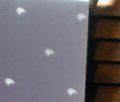 |
Scott A. Griswold,
Southington, Connecticut |
#1,
#2 |
S. Griswold: "I captured the multiple-image
shot indoors through a window using pinhole projection before
mid-eclipse. The other
shot was taken with an Epson PhotoPC 800 digital camera held
to one lens on a pair of binoculars while using the other lens
to locate the sun. Both lenses were covered with Solar Skreen
filter. " |
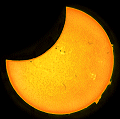 |
Bob LaPree,
Contoocook, NH |
#1 |
Photo information: Coronado Filters Hydrogen
Alpha ASP-60 filter on a TeleVue Pronto; Nikon Coolpix 990 camera
at 1/15 sec. f3.7, asa 100. |
 |
Ben
Walden, Greenlawn, NY |
#1 |
B. Walden: "I took this photo as I projected
the images onto a board using standard binoculars. The picture
shows the two projected images of the partially eclipsed sun
from Greenlawn, NY at 11:55 am est. " |
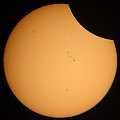 |
Brian
Harvey, Hollister, CA |
#1 |
B. Harvey: "Using my new Solar Filter, I
took several digital pictures using my Sony Cybershot Digital
Camera.. This was my first attempt with my digital camera and
the solar filter. " |
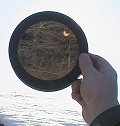 |
Mary
Moffitt, Manchester, CT |
#1 |
Arthur Moffitt: "Kevin Coe of Portland CT
holds an Orion 4.5 inch solar filter with trees reflecting from
behind. Picture taken by Mary Moffitt with a Canon PowerShot
A50." |
 |
Michael
Gordon, Marion, OH |
#1,
#2 |
Photo details: Fuji Reala 100 film; Olympus OM-10
camera; 10" f/10 Schmidt-Cassegrain telescope with a full
aperture solar filter. |
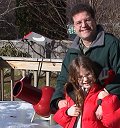 |
Don Koenigsberg,
Bryn Mawr, PA |
#1,
#2, #3 |
Don and Rebecca Koenigsberg (pictured)
used an Edmund Astroscan telescope to safely project images
of the partial eclipse onto a screen about 2 feet from the eyepiece. |
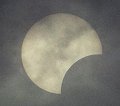 |
Richard Nugent,
Conroe, TX |
#1 |
R. Nugent: "We had overcast drizzly skies
continuously here in southeast Texas, but I patiently waited
for small breaks in the clouds and snapped this photo between
11:00 AM - 11:30 AM." Photo details: Exposure: 1/500 second
(no filter) Film: Fuji 400 print film Telescope: Meade 2045D
4 inch SCT. |
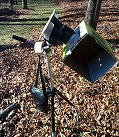 |
Keith
Burns, Atlanta, GA |
#1,
#2 |
K. Burns: "My
setup was rather primitive, but it worked. I used a pair
of tripod-mounted 8x56 binoculars and built a cardboard viewing
box. Attached to the front of the binoculars was a two hole punched
piece of cardboard thus the two
images present. I took pictures using a Kodak DC 210 digital
camera." |
|
[IMAGE] |
Jay Edwards,
Maine, NY |
#1 |
Jay Edwards: "Because of snow showers and
-23 degree wind chill factor we decided to keep it simple. We
shot [the eclipse] using my 80 MM, f/5 refractor, with a 25 mm
eyepiece and Panasonic camcorder in afocal mode. Although it's
not visible in this camcorder shot, there was a very long sunspot
chain near the center of the disk that made for a beautiful view
visually!" |
|
[IMAGE] |
Jeff Boyne,
La
Crosse, WI |
more
images |
Mike Welvaert, Randy Breeser, and Jeff Boyne
of the National Weather Service in La Crosse, Wisconsin used
the pin hole method, a pair of binoculars, and a pair of solar
glasses to observe the solar eclipse on Christmas morning/early
afternoon. Lots of their images are posted here. |